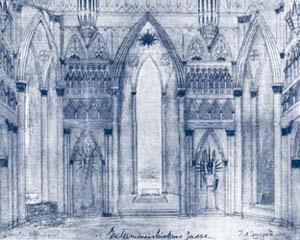A Biographical Multimedia Mosaic...
Antikrist (Antichrist)
Rued Langgaard only wrote one opera, which in the original version from 1921-23 bore the title Antikrist.

Langgaard himself drew the suggested set designs for Antikrist in 1923. There was to be but one set throughout
the whole performance. "The Altar of Darkness" can be seen on the right, and that of light on the left. The centre space
opens out to "eternity", and the altar of Antichrist is placed in the opening. (Reproduced from a cutting from the
"Nationaltidende", 1924).
The first version of the opera centred round a dramatic psychological plot involving a man who plans to realise the
biblical prophecies about Antichrist in order thereby to provoke the end of the world. In the revised version the plot has
been eliminated, and all the figures are allegorical.
The opera was rejected by the Royal Theatre on account of the text, which had been written by the composer
himself. This rejection was a somewhat suspicious affair - but in all likelihood the theatre management did not like the
genre, which was a religious "mystery opera". Perhaps, too, at a time when the name of Langgaard had almost become
synonymous with fiasco, it would have called for more than ordinary boldness to take a chance on him.
In 1926-30 Langgaard revised the work with a new libretto, but all to no avail. Once more, the unsuitable nature of the text
was given as the reason for rejecting the work.
The final version had a succession of titles, including Kremàscó, a word invented by Langgaard himself. In the end he would appear to have preferred the title Fortabelsen (Antikrist) (Damnation - Antichrist). An excerpt from the opera was performed on the radio in 1940, and in 1980 it was produced in its entirety by Danish Radio - though as yet no one has dared to try and perform this expressive, oratorio-style work on stage.
The opera depicts the final days of modern civilisation, marked by decadence, pride, materialism, squabbling and wrangling. Faith is the only saving force Langgaard can see. The opera is performed on a heavily symbolic set, a permanent feature of which are the flickering gas-lamps which were a typical Langgaard symbol for the decadent atmosphere of the fin de siècle period.
In musical terms there is evident influence from Wagner (Parsifal), Richard Strauss (Salome) and Arnold Schönberg (Gurrelieder). In addition, large passages from Langgaard's most experimental works, Sfærernes Musik (Music of the Spheres) and Symphony No. 6, form part of the opera's composite musical universe.